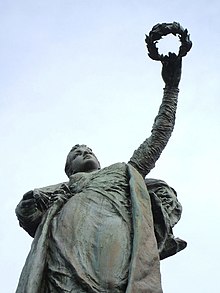Sydney March
| Sydney March | |
|---|---|

Royal Inniskilling Fusiliers South African War Memorial
|
|
| Born | 1876 Stoneferry, Kingston upon Hull, East Riding of Yorkshire, England |
| Died | 1968, Second quarter Kent, England |
| Nationality | British |
| Education | Royal Academy Schools |
| Known for | Sculpture |
| Notable work | "Mafeking 1900" "King Edward VII" "Cecil John Rhodes" Bromley War Memorial National War Memorial of Canada |
| Awards | First Prize, Silver Medal, 1900, Royal Academy Schools |
English sculptor Sydney March (1876–1968) was a prolific artist, whose primary focus was portrait busts and other sculptures of British royalty and contemporary figures, as well as war memorials. One of eight artists in his family, he and his siblings completed the National War Memorial of Canada after the death of their brother Vernon March in 1930.
Sydney March, son of George Henry March and his wife Elizabeth Blenkin, was born in 1876 in Stoneferry, a suburb of Kingston upon Hull, in the East Riding of Yorkshire, England. At the time of the 1891 census, Sydney worked as a monumental sculptor's apprentice. His father was a seed crusher foreman (oil miller). By 1901, the family had moved to Battersea, London, where his father was employed as a builder's clerk. Sydney studied at the Royal Academy Schools. He was the second of nine children, eight of whom became artists. Three of the March children became sculptors, Sydney, Elsie, and Vernon. The other five artists were Edward, Percival, Frederick, Dudley, and Walter. The ninth sibling was a sister, Eva. Their parents died in 1904.
By 1911, all nine siblings, as yet unmarried, were living together in the 17-room house "Goddendene" in Farnborough, Kent, England. Only two of the March siblings ever married, and between them produced three children. Eva married Charles Francis Newman in 1916. They had a daughter, Heather. Sydney's brother Frederick married Agnes Annie Gow in 1926. They had two children, Elizabeth and Cecil.
Sydney and his siblings established studios at the family home of Goddendene in Locksbottom, Farnborough after 1901. The seven acre grounds had not only three large studios, but also a metal foundry. The studio walls could be slid back, such that the artists could work in natural daylight. The walls of the studios were sufficiently tall that parachutes could be hung to dry during the war.
In 1900, the Royal Academy Schools awarded Sydney first prize, a silver medal, for a model of a statue or group. Between 1906 and 1932, Sydney March exhibited thirteen times at The Exhibition of the Royal Academy of Arts. He exhibited a total of seventeen works at the Royal Academy, primarily portrait busts, statuettes, and equestrian statues.
...
Wikipedia
